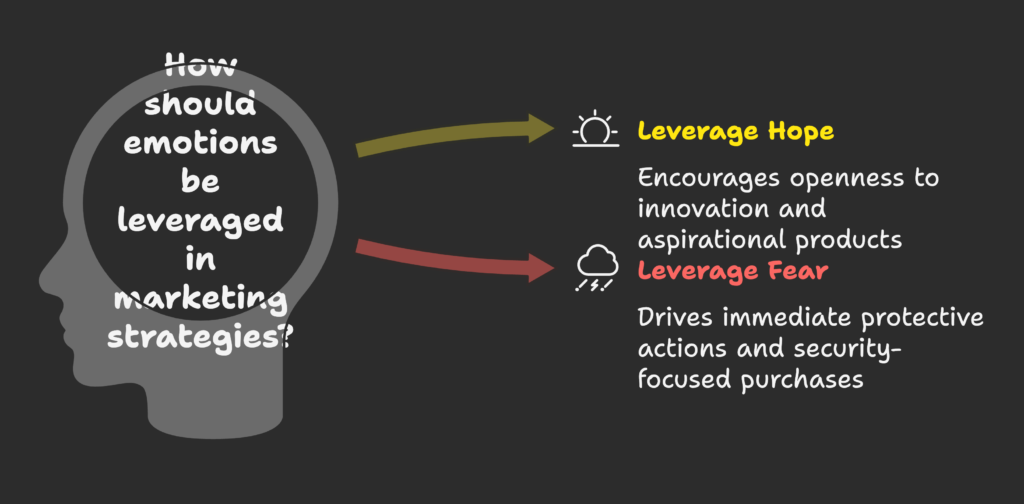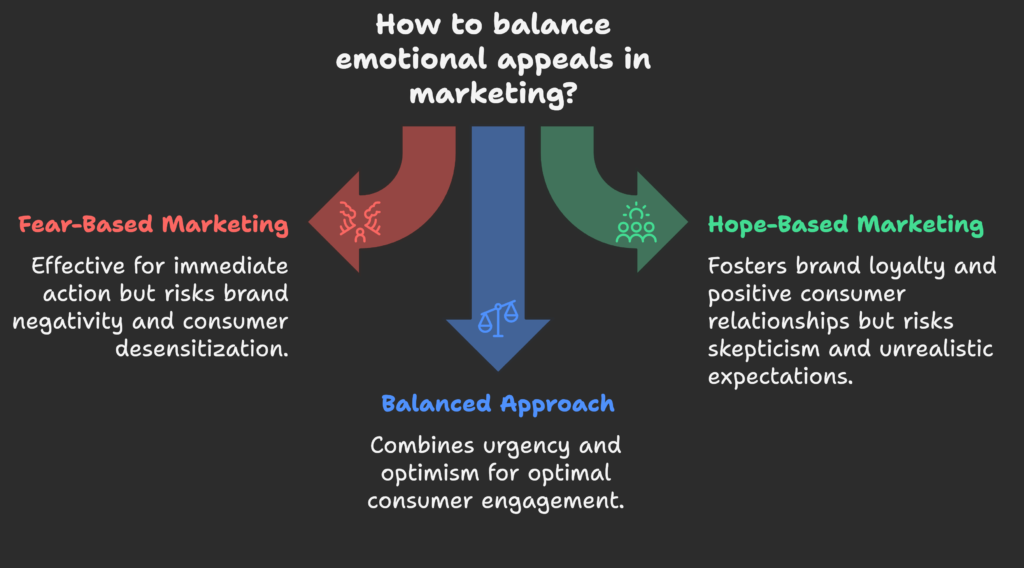Have you ever wondered why some ads make your heart race with excitement, while others tap into your deepest worries? Imagine learning how to harness these emotions in a way that inspires action but doesn’t overwhelm. In this article, you will discover how hope and fear both influence buying decisions, and how you can skillfully balance them to create powerful marketing messages. By the end, you’ll have a clear roadmap for connecting with customers on a deeper level. Ready to explore the power of hope and fear? Let’s get started!
In this opening section, we’ll explore how emotion lies at the core of consumer decision-making. We’ll define hope and fear in a marketing context and learn why balancing them can give your brand a competitive edge. Stick around to find out how these insights can transform your marketing strategy. Next, we’ll dive into the fascinating psychology behind these emotions.
The Emotional Foundations of Consumer Decision-Making
Consumers rarely buy purely based on facts. They buy based on how they feel. Over the years, marketing has moved from focusing on cold facts to tapping into our emotional triggers. Scientific studies show that when people make decisions, the emotional centers of the brain often light up before the rational centers do. Dopamine release, which signals reward anticipation, plays a huge role here.
Statistics suggest that a large portion of purchasing behaviors are driven by feelings like security, excitement, or even status. As people become more aware of their own emotional responses, brands also need to be more aware of how they use these triggers. Curious to know what these triggers are? Let’s move on to see how hope and fear each play a role in shaping consumer actions.
Defining Hope and Fear in the Marketing Context
Hope is that spark of enthusiasm for a better future. In marketing, it’s often used to show how your life could improve if you buy a certain product or service. People picture themselves happier, healthier, or more successful—this positive image drives them to act.
Fear, on the other hand, is about avoiding danger or loss. It’s wired into our survival instincts. In advertising, fear can appear as warnings about missing out on a deal or facing consequences if you don’t take action. When used responsibly, it can motivate quick decisions.
Both hope and fear can be extremely compelling. When balanced, they work like two sides of a coin, providing both excitement about what could go right and caution about what could go wrong. Sound intriguing? Up next is why this emotional balance is so powerful for businesses.
The Business Case for Emotional Balance
Brands that rely only on fear can scare customers away in the long run. Brands that rely only on hope risk becoming unrealistic. Finding the right emotional mix can:
- Help you achieve short-term results (immediate sales) and long-term loyalty.
- Shape a healthier brand perception by showing you understand both challenges and aspirations.
- Promote customer retention as people feel more connected to a brand that acknowledges real concerns while offering uplifting solutions.
- Differentiate you from competitors that might be stuck in one emotional tone.
So, we’ve laid the groundwork for understanding hope and fear. Next, let’s dive deeper into the fascinating neuroscience and psychology that make these emotions so potent in marketing.
Psychological Foundations of Hope and Fear
In this section, get ready to learn how your brain reacts to hopeful and fearful messaging. We’ll look at brain chemistry, explore theories that explain how emotions expand or limit our thinking, and see how concepts like loss aversion affect buying behavior. By the end, you’ll have a better sense of why these emotions can be so persuasive. Feeling curious? Let’s unpack the science behind it all. 
The Neuroscience of Hope and Fear
Brain scans reveal that hope and fear activate different areas. Hope can stimulate regions linked with reward anticipation, often involving dopamine release (Lachhwani, 2020). Meanwhile, fear taps into survival mechanisms and triggers the amygdala’s alarm system. This leads to a fight-or-flight response, which can be powerful but needs careful handling in marketing.
Marketers who understand these dynamics can craft messages that generate excitement for a better future or a strong urge to prevent negative outcomes. Ready to see how this ties into broader psychological theories? Let’s move on.
The Broaden-and-Build Theory in Marketing
When people feel hopeful, they tend to broaden their thinking. They explore new ideas and are more open to innovation. In contrast, fear can narrow people’s focus, making them look for quick fixes or immediate protective actions. This is the essence of the broaden-and-build theory.
In product marketing, hope can make consumers more receptive to aspirational products, while fear-based messaging often pushes them toward security-focused or protective purchases. Balancing these emotions ensures your message resonates with a wider audience. Let’s see how another theory—prospect theory—adds an extra layer of insight.
Prospect Theory and Loss Aversion
Prospect theory tells us that people often fear losing something more than they value gaining something of equal worth. This explains why promotions like “Don’t miss out on these savings” work so well. It’s not just about getting a deal; it’s about avoiding a loss.
But you can’t always shout “Don’t miss out!” Emphasizing potential gains (hope) can be just as impactful. The trick is knowing when to highlight each side. Ready to explore how these approaches have changed over time? Let’s take a look at the evolution of emotional marketing.
The Evolution of Emotional Appeals in Marketing
We’re about to explore how fear took center stage in older campaigns, followed by a shift toward hope-driven, aspirational marketing. Then, we’ll see how many brands now blend both approaches. By the end, you’ll see that emotional marketing isn’t new—it’s constantly evolving. Let’s look at how fear-based appeals first gained traction.
Historical Perspective on Fear in Advertising
Fear-based ads have existed for decades. Early campaigns often used scare tactics to sell products ranging from toothpaste to security systems. In the 20th century, these tactics became common, but as audiences grew savvy, regulations stepped in to prevent manipulation (Salvatera, 2024).
Over time, cultural attitudes changed. People began seeking positivity and optimism, leading to a more balanced approach. Wondering how hope gained momentum? Let’s dive into the next subtopic.
The Rise of Aspirational and Hope-Centered Marketing
Aspirational marketing took off when brands discovered consumers wanted to picture themselves living an improved life. Lifestyle ads and brand purpose statements started replacing dread-inducing warnings. Social media accelerated this trend, as sharing uplifting messages proved more engaging than constant negativity.
From travel ads showing scenic getaways to tech products promising a better future, hope-centered campaigns flourished. But in today’s world, a purely positive approach isn’t always enough, which is why many brands now integrate multiple emotions. Curious how they do it? Keep reading.
The Integrated Emotional Approach
Integrated campaigns use fear to highlight potential risks and hope to offer solutions. Think of security software ads: they might stress the threat of hacking but also paint a hopeful picture of peace of mind once you’re protected.
Over the years, consumers have grown more emotionally literate. They spot blatant fear-mongering, but they also respond well to genuine positivity. That’s why successful campaigns blend the two. Ready to explore how fear alone can still be very effective? Let’s dive into its strengths and limitations.
The Effectiveness of Fear-Based Marketing
Now we’ll see why fear appeals can drive quick action and learn when they’re most effective. We’ll also uncover the potential pitfalls of leaning too heavily on this intense emotion. Interested in learning the science behind scaring people into action? Read on.
Psychological Mechanisms of Fear Appeals
Fear in marketing works by grabbing immediate attention. Our brains want to protect us from threats, so we tune in quickly when we sense danger. Whether it’s fear of missing a sale or fear of a bad outcome, this emotion can be a powerful motivator.
But fear is a double-edged sword (Cohen, 2018). If it’s too strong, people may shut down or become defensive. Finding the right level of tension is key. Coming up next: specific scenarios where fear really shines.
When Fear Works Best in Product Marketing
Fear-based marketing tends to excel in:
- Health products – Warnings of health risks can prompt immediate lifestyle changes.
- Security and finance – Highlighting threats to savings or identity can motivate swift action.
- Risk-averse audiences – People who prioritize safety or stability often respond strongly.
Research from the University of Chicago suggests that fear can be especially effective among those who already have a heightened sense of concern. Still, there’s a limit to how often you can use it before people tune out. Let’s look at why relying solely on fear might be dangerous.
Limitations and Risks of Fear-Dominant Marketing
Constantly playing on fear can make your brand seem negative and even exploitative. Overexposure to fearful messages may desensitize consumers, reducing effectiveness over time. Ethical issues also arise: is it right to scare people into buying?
Because of these concerns, many marketers choose a balanced approach. Speaking of balance, let’s move into how hope-based marketing works—and its own set of challenges.
The Effectiveness of Hope-Based Marketing
Next, we’ll see how hope taps into people’s desire for a better future. We’ll also explore examples of products that do well with hope appeals and where this strategy might fall short. Eager to find out why hope can boost loyalty? Read on.
Psychological Mechanisms of Hope Appeals
Hope promotes approach behavior. When people see a product that promises improvement, they lean toward trying it. This can boost customer loyalty because you’re encouraging them to envision lasting benefits (Anonymous, 2012).
Consumers who feel hopeful often develop a stronger emotional bond with the brand, seeing it as a partner in their journey toward success or happiness. Ready to learn which products thrive on hope? Let’s look at that next.
When Hope Works Best in Product Marketing
Hope-driven ads do wonders for:
- Lifestyle brands – Showing the ideal life can spark big dreams.
- Personal development products – Courses, coaching, or anything that promotes self-improvement.
- Health and wellness – People want to believe in positive changes for their mind and body.
Case studies often highlight strong, uplifting messaging that resonates with optimistic consumers. However, too much positivity can sometimes backfire. Let’s see why.
Limitations and Risks of Hope-Dominant Marketing
Unrealistic promises can generate skepticism. If a product claims to solve all your problems overnight, people might question its credibility. “Toxic positivity” can also irritate those who feel their genuine fears aren’t being acknowledged.
That’s why a solely hope-based approach can falter. Combining the right dose of realism with optimism is key. And that leads us to the heart of our discussion: finding the perfect blend of hope and fear.
Finding the Perfect Hope-Fear Balance
Get ready to see how blending hope and fear can yield impressive results. We’ll explore why humans respond to this dual strategy and how to implement frameworks for striking the right emotional mix. Eager to see the research? Let’s jump in.

The Complementary Nature of Hope and Fear
We often crave both security and growth. Hope speaks to our desire for something better, while fear reminds us of what we stand to lose if we don’t act. Studies (Anonymous, 2020) show that new product adoption can soar when consumers feel both excited (hope) and nervous (fear) about missing out.
Timing matters here. Early in a product journey, mild fear can create urgency, while hope keeps people motivated. Next, we’ll see how to set up a framework for using these emotions effectively.
Strategic Frameworks for Balancing Emotional Appeals
One popular model is the pain-solution-gain approach:
- Pain: Present a fear or concern (e.g., “Your data might be at risk”).
- Solution: Show how your product resolves this pain, gently shifting toward hope.
- Gain: Paint a hopeful scenario of life after the problem is solved.
You can sequence these messages differently in various channels. For example, your social media posts might focus on hope, while targeted emails might emphasize the potential risk of ignoring the offer. Looking to optimize this mix? Let’s see how testing can help.
Testing and Optimizing Emotional Balance
A/B testing can measure how different emotional tones affect clicks, conversions, or even brand sentiment. Surveys and user experience research let you see if you’re striking the right chord between positivity and concern.
It’s a continuous process: tweak, measure, and refine until you find that sweet spot. Next, we’ll put these ideas into concrete action across different industries.
Implementation Strategies Across Industries
Now we’ll dive into real-world examples of how hope and fear can be applied in various sectors. From health products to financial services, you’ll discover why each industry needs a slightly different emotional formula. Ready to see this in action? Let’s go.
Health and Wellness Products
People want to avoid poor health outcomes (fear) and embrace a healthier, more energetic life (hope). Many health campaigns use statistics to show risks, then follow up with an encouraging message about a brighter future if you make the right choices (Anonymous, 2020).
Regulations can be strict here, so it’s crucial to stay factual while still stirring emotion. Up next, we’ll see how this balance plays out in finance.
Financial Products and Services
Financial marketers often highlight the fear of losing money or missing retirement goals. But they also promise a hopeful path to wealth-building or debt-free living. Regulatory frameworks mean you must be responsible in your messaging.
Different demographics respond differently. Younger audiences may be more drawn to hope-based messages about financial freedom, while older consumers might resonate more with security and protection. Let’s now shift to the tech sector.
Technology and Innovation Products
New tech can spark fear of obsolescence (“Stay updated or get left behind!”) and also offer the hope of innovation (“Experience the future now!”). Early adopters love the excitement of having the latest gadget, while mainstream consumers often need reassurance they aren’t making a risky investment.
Companies like Apple often balance desire for sleek new features (hope) with fear of missing out on must-have tech. Intrigued? Let’s see how everyday products fit into this picture.
Consumer Packaged Goods and Everyday Products
For everyday items, subtle emotional triggers can be effective. People might fear wasting money on poor-quality products or missing out on an upgrade to something better. Simultaneously, they hope to find consistent reliability or a small joy in daily life.
Building brand loyalty through balanced emotional cues can be especially rewarding for mass-market products. Curious how to craft these messages? Next, we’ll look at communication techniques for blending hope and fear.
Crafting Emotionally Balanced Marketing Communications
Ready to apply these principles to your creative assets? This section reveals how visuals, language, and specific marketing channels can convey both hope and fear in a harmonious way. Let’s start with design psychology.
Visual Elements and Design Psychology
Design plays a huge role in emotional impact. Colors can signal urgency (red) or optimism (bright shades), while images of smiling faces evoke hope. Fearful imagery might include subtle hints of risk, like a dark background or a warning icon.
The key is balance. You don’t want visuals that shock too intensely or feel overly sugar-coated. Next, we’ll explore language choice in more detail.
Linguistic Techniques for Emotional Balance
Headlines can blend urgency with optimism. For example: “Don’t Let Your Savings Slip Away—Grow Them with Our Proven Investment Plan.” You mention a risk but quickly pivot to a positive outcome.
In the body text, share success stories to highlight hope, then sprinkle in data or warnings that remind people what happens if they ignore the solution. Finally, your call-to-action should motivate while still sounding genuine. Ready to put this into different marketing channels? Let’s go.
Channel-Specific Implementation Strategies
- Social Media: Light, quick messages or eye-catching graphics can show bright possibilities, balanced by short notes of what might happen otherwise.
- Email Marketing: Sequence your emails to open with a concern, followed by a hopeful resolution in the next message. This maintains interest over time.
- Video Content: Timing is everything. Show a dramatic moment of risk early on, followed by a visual journey toward a successful outcome.
- Website Experience: Use clear navigation and well-placed headlines that alternate between addressing fears and highlighting benefits.
Now that you know how to craft your communications, let’s see how to measure their impact.
Measuring the Impact of Emotionally Balanced Marketing
It’s time to learn how to track whether your hope-fear mix is working. We’ll discuss key metrics, research methods, and ways to evaluate return on investment (ROI). Ready for some actionable insights? Let’s go.
Key Performance Indicators for Emotional Marketing
In the short term, look at click-through rates and conversions. Over the long haul, measure brand perception and customer loyalty. Balanced emotional campaigns often show higher engagement and more repeat purchases than one-note fear or hope campaigns.
You can also track customer lifetime value to see how emotional messaging affects overall profitability. Next, we’ll delve deeper into research methodologies.
Research Methodologies for Emotional Impact
- Neurological and Biometric Measurements: Some brands use advanced tools to measure brain activity and stress responses.
- Surveys: Ask customers how they felt during or after encountering your campaign.
- Qualitative Research: Interview or hold focus groups to get deeper emotional insights.
- Social Listening: Monitor online comments to gauge positive versus negative sentiment.
Each approach offers different insights. Next, we’ll see how all this ties back to ROI.
ROI Analysis and Business Impact
Try to connect emotional marketing efforts to actual sales, sign-ups, or brand lifts. Use attribution models to pinpoint which emotional elements contributed most. Compare your performance against competitors—brands that master emotional balance often gain long-term loyalty.
Measuring ROI goes beyond money; it’s also about building a trustworthy image. Let’s wrap up measurement and move on to important ethical considerations.
Ethical Considerations in Emotional Marketing
Now we’ll look at the moral side of tapping into hope and fear. How do you influence without manipulating? How do you respect cultural nuances? By the end, you’ll see how ethics and authenticity can be your brand’s best friend. Let’s start with the line between influence and manipulation.
Avoiding Manipulation in Emotional Appeals
Influence is guiding customers with honest messages. Manipulation crosses the line when you deliberately mislead or exploit vulnerabilities. Transparency helps build trust and keeps you clear of ethical traps. Vulnerable groups, such as the elderly or those facing serious health issues, deserve special care (Markitome, 2023).
Keeping ethics front and center means your campaigns can be both emotionally compelling and respectful. Next, we’ll consider cultural factors.
Cultural and Contextual Sensitivity
Emotional responses vary by culture. Some societies find open discussion of fear acceptable, while others view it as taboo. Hope messaging can also differ if local traditions emphasize community well-being over individual aspirations.
Adapting your approach is vital. Understanding local values and social norms ensures your campaigns feel relevant rather than tone-deaf. Let’s see how to make your emotional marketing even more authentic.
Building Authentic Emotional Connections
Authenticity starts with aligning your brand values with your emotional messages. If you promise hope, your product or service should genuinely deliver. Consistency across multiple campaigns helps you build a lasting emotional relationship with customers.
By balancing short-term sales with long-term trust, you foster loyalty that keeps people coming back. Next up, we’ll see some real-life case studies of brands that got this balance right.
Case Studies of Successful Emotional Balance
Ready for some real-world success stories? In this section, we’ll look at how the insurance, health and wellness, and tech sectors have used fear and hope to connect with audiences. Let’s begin with an industry once infamous for fear-based tactics.
Insurance Industry Transformations
Insurance ads used to rely heavily on fear—storm damage, accidents, theft. Now, some companies highlight peace of mind and future security. Brands like LV= or Direct Line, for example, add hopeful narratives about what customers can gain if they stay safe (Gillingwater, 2020).
Industry-wide, we see a move toward balanced messaging, showing how real-world dangers exist but also emphasizing a brighter outcome. Curious about health and wellness? Let’s move on.
Health and Wellness Success Stories
Anti-smoking campaigns once used harsh visuals to scare people. Modern efforts often combine those strong images with hopeful messages about improved health if you quit (Anonymous, 2020). Fitness brands also blend concern about inactivity with inspiring tales of transformation.
By mixing cautionary warnings with uplifting stories, these campaigns encourage realistic yet motivating action. Let’s see how tech manages both fear of missing out and excitement for the future.
Technology and Innovation Leaders
Apple is known for creating “FOMO” around new launches but also inspiring hope with sleek design and lifestyle enhancements. Software-as-a-service companies highlight what you could lose by sticking to outdated tools, then promise higher efficiency and success with upgrades (Seth Godin, 2020).
The gaming industry also expertly weaves fear of missing epic game releases with the excitement of new virtual worlds. Intrigued about where emotional marketing is headed? Let’s look at future trends next.
Future Trends in Emotional Marketing Balance
Wondering what’s next for hope and fear in marketing? In this section, we’ll explore how AI and other emerging technologies will shape emotional appeals, and how consumer expectations are evolving. Let’s jump into the tech side first.
Technological Advancements in Emotional Marketing
AI now helps brands personalize emotional appeals in real-time. Biometrics, like facial recognition, could measure user responses and adjust the marketing on the spot (Kadence, 2025). Virtual and augmented reality will allow people to “feel” a product experience, blending excitement and caution in ways we’ve never seen before.
But technology also raises privacy questions, making balance and ethics more important than ever. Next, let’s look at emerging generations.
Evolving Consumer Expectations
Generations Z and Alpha are growing up in a highly connected world. They’re exposed to many ads and often know when an appeal is manipulative. They crave authenticity and can quickly dismiss brands they feel are “faking it.”
Global crises like economic downturns or pandemics also change how people respond to fear and hope. Being aware of these external factors can help you craft more relatable campaigns. Lastly, let’s see how emotional marketing can integrate across the entire customer experience.
Integrated Emotion Management Across Customer Experience
Emotional marketing shouldn’t stop at ads. It can influence product design, customer service interactions, and community building. Providing a well-rounded experience—where hope and fear are balanced from the first ad to the final user interaction—keeps customers engaged and loyal (Anonymous, 2020).
Now, let’s move on to our conclusion, where we’ll summarize what we’ve learned and provide strategic recommendations for taking your marketing to the next level.
Conclusion and Strategic Recommendations
Congratulations on making it this far! In this final section, we’ll tie everything together. You’ll learn guiding principles for creating balanced emotional marketing, plus insights into how this approach can give you a competitive advantage. Ready for a final burst of inspiration?
Guiding Principles for Balanced Emotional Marketing
Here’s a simple checklist for assessing and implementing a hope-fear balance:
- Assess Current Emotional Tone: Look at your existing materials and identify if you’re too heavy on fear or exclusively positive.
- Set Clear Goals: Choose whether you need immediate action (lean on fear) or long-term engagement (lean on hope).
- Test and Refine: Run A/B tests to see how your audience responds. Adapt based on real data.
- Stay Authentic: Deliver on your promises. Consistency builds lasting trust.
Sticking to these principles ensures your messages feel genuine, striking the perfect emotional chord with your audience. Want to see how this can give you an edge? Keep reading.
The Competitive Advantage of Emotional Sophistication
Companies that master emotional balance often stand out in crowded markets. They create strong bonds with customers who feel both heard and uplifted. Over time, this fosters resilient relationships, improving both brand perception and profitability.
Training your team to use emotional cues responsibly and consistently can be a game-changer. Combined with ongoing testing, these strategies can keep you ahead of the curve.
By the way, if you’re running a Shopify store and want to boost your sales, don’t forget to check out Growth Suite. It’s a handy tool that can help you implement many of the strategies you’ve just learned, simplifying the process of crafting balanced emotional campaigns.
We’ve covered a lot of ground, from the neuroscience of hope and fear to ethical considerations and future trends. Now that you have a full picture of how to balance these two powerful emotions, it’s your turn to create marketing magic that resonates with your audience.




